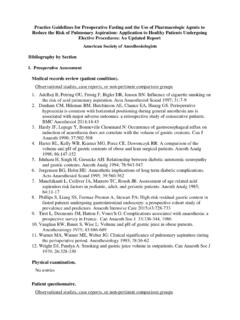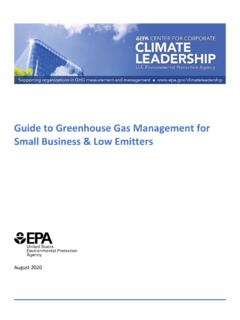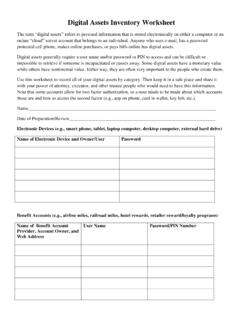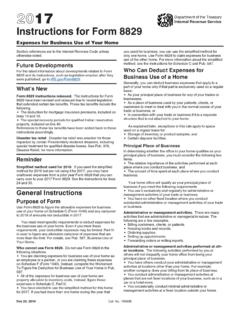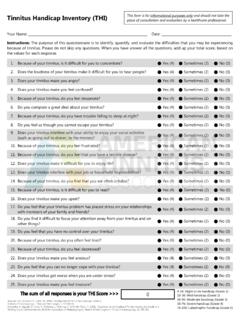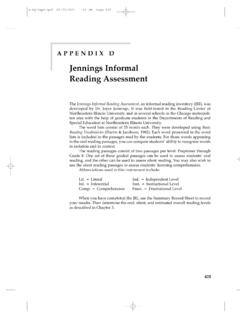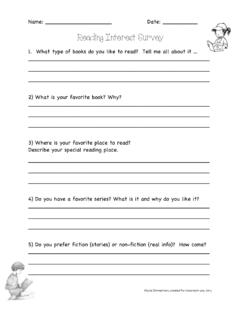Transcription of The Neuropsychiatric Inventory Questionnaire
1 NpiTESTThe Neuropsychiatric InventoryQuestionnaire:Background and AdministrationBy Jeffrey L. Cummings, MD The Neuropsychiatric Inventory Questionnaire : Background and Administration The Neuropsychiatric Inventory Questionnaire (NPI-Q) was developed and cross-validated with the standard NPI to provide a brief assessment of Neuropsychiatric symptomatology in routine clinical practice settings (Kaufer et al, J Neuropsychiatry Clin Neurosci 2000, 12:233-239). The NPI-Q is adapted from the NPI (Cummings et al, Neurology 1994; 44:2308-2314), a validated informant-based interview that assesses Neuropsychiatric symptoms over the previous month.
2 The original NPI included 10 Neuropsychiatric domains; two others, Nighttime Behavioral Disturbances and Appetite/Eating Changes, have subsequently been added. Another recent modification of the original NPI is the addition of a Caregiver Distress Scale for evaluating the psychological impact of Neuropsychiatric symptoms reported to be present (Kaufer et al, JAGS, 1998;46:210-215). The NPI-Q includes both of these additions. The NPI-Q is designed to be a self-administered Questionnaire completed by informants about patients for whom they care. Each of the 12 NPI-Q domains contains a survey question that reflects cardinal symptoms of that domain.
3 Initial responses to each domain question are "Yes" (present) or "No" (absent). If the response to the domain question is "No", the informant goes to the next question. If "Yes", the informant then rates both the Severity of the symptoms present within the last month on a 3-point scale and the associated impact of the symptom manifestations on them ( Caregiver Distress) using a 5-point scale. The NPI-Q provides symptom Severity and Distress ratings for each symptom reported, and total Severity and Distress scores reflecting the sum of individual domain scores. Most informants will be able to complete the NPI-Q in 5 minutes or less. It is recommended that responses to the NPI-Q be reviewed for completeness by a clinician and for clarifying uncertainties after each administration.
4 The first time an informant completes the NPI-Q, it may be useful to verbally review the instructions. In some instances, it may be necessary to conduct the NPI-Q in part or entirely as an interview. The NPI and NPI-Q are both copyright-protected by Jeffrey L. Cummings, MD. The NPI-Q was developed by Daniel Kaufer, MD with permission. Use of the NPI or NPI-Q in investigational studies sponsored in whole or part by for-profit entities is prohibited without express written consent. For inquiries regarding the NPI-Q, contact: Jeffrey L. Cummings, MD Mary S. Easton Center for Alzheimer's Disease Research 10911 Weyburn Ave; #200 Los Angeles, CA 90095 The NPI-Q can be found at: Please answer the following questions based on changes that have occurred since the patient first began to experience memory problems.
5 Circle "Yes" only if the symptom(s) has been present in the last month. Otherwise, circle "No". For each item marked "Yes": a) Rate the SEVERITY of the symptom (how it affects the patient): 1 = Mild (noticeable, but not a significant change) 2 = Moderate (significant, but not a dramatic change) 3 = Severe (very marked or prominent, a dramatic change) b) Rate the DISTRESS you experience due to that symptom (how it affects you): 0 = Not distressing at all 1 = Minimal (slightly distressing, not a problem to cope with) 2 = Mild (not very distressing, generally easy to cope with) 3 = Moderate (fairly distressing, not always easy to cope with) 4 = Severe (very distressing, difficult to cope with) 5 = Extreme or Very Severe (extremely distressing, unable to cope with) Please answer each question carefully.
6 Ask for assistance if you have any questions. Delusions Does the patient have false beliefs, such as thinking that others are stealing from him/her or planning to harm him/her in some way? Yes No SEVERITY: 1 2 3 DISTRESS: 0 1 2 3 4 5 Hallucinations Does the patient have hallucinations such as false visions or voices? Does he or she seem to hear or see things that are not present? Yes No SEVERITY: 1 2 3 DISTRESS: 0 1 2 3 4 5 Agitation/Aggression Is the patient resistive to help from others at times, or hard to handle? Yes No SEVERITY: 1 2 3 DISTRESS: 0 1 2 3 4 5 Depression/Dysphoria Does the patient seem sad or say that he /she is depressed?
7 Yes No SEVERITY: 1 2 3 DISTRESS: 0 1 2 3 4 5 Anxiety Does the patient become upset when separated from you? Doeshe/she have any other signs of nervousness such as shortness of breath, sighing, being unable to relax, or feeling excessively tense? Yes No SEVERITY: 1 2 3 DISTRESS: 0 1 2 3 4 5 Elation/Euphoria Does the patient appear to feel too good or act excessively happy? Yes No SEVERITY: 1 2 3 DISTRESS: 0 1 2 3 4 5 Apathy/Indifference Does the patient seem less interested in his/her usual activities or in the activities and plans of others?
8 Yes No SEVERITY: 1 2 3 DISTRESS: 0 1 2 3 4 5 Disinhibition Does the patient seem to act impulsively, for example, talking to strangers as if he/she knows them, or saying things that may hurt people's feelings? Yes No SEVERITY: 1 2 3 DISTRESS: 0 1 2 3 4 5 Irritability/Lability Is the patient impatient and cranky? Does he/she have difficulty coping with delays or waiting for planned activities? Yes No SEVERITY: 1 2 3 DISTRESS: 0 1 2 3 4 5 Motor Disturbance Does the patient engage in repetitive activities such as pacing around the house, handling buttons, wrapping string, or doing other things repeatedly?
9 Yes No SEVERITY: 1 2 3 DISTRESS: 0 1 2 3 4 5 Nightime Behaviors Does the patient awaken you during the night, rise too early in the morning, or take excessive naps during the day? Yes No SEVERITY: 1 2 3 DISTRESS: 0 1 2 3 4 5 Appetite/Eating Has the patient lost or gained weight, or had a change in the type of food he/she likes? Yes No SEVERITY: 1 2 3 DISTRESS: 0 1 2 3 4 5 Developed by Daniel Kaufer, MD. Final Version 6/99. JL Cummings, 1994; all rights reserved NPI-Q SUMMARY No Severity Caregiver Distress Delusions 0 0 1 1 2 3 0 0 1 2 3 4 5 Hallucinations 0 0 1 1 2 3 0 0 1 2 3 4 5 Agitation/Aggression 0 1 1 2 3 0 0 1 2 3 4 5 Dysphoria/Depression 0 0 1 1 2 3 0 0 1 2 3 4 5 Anxiety 0 0 1 1 2 3 0 1 2 3 4 5 Euphoria/Elation 0 0 1 1 2
10 3 0 0 1 2 3 4 5 Apathy/Indifference 0 0 1 1 2 3 0 0 1 2 3 4 5 Disinhibition 0 0 1 1 2 3 0 0 1 2 3 4 5 Irritability/Lability 0 0 1 1 2 3 0 0 1 2 3 4 5 Aberrant Motor 0 0 1 1 2 3 0 0 1 2 3 4 5 Nighttime Behavior 0 0 1 1 2 3 0 0 1 2 3 4 5 Appetite/Eating 0 0 1 1 2 3 0 0 1 2 3 4 5 TOTAL JCummings, 1994; all rights reserved




